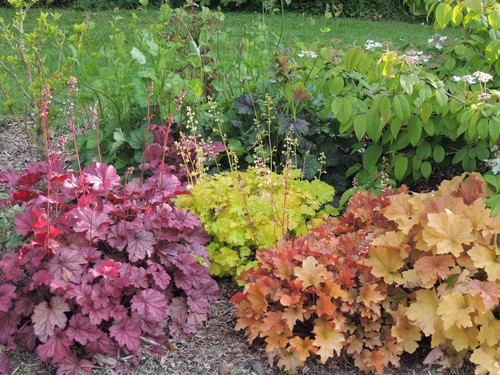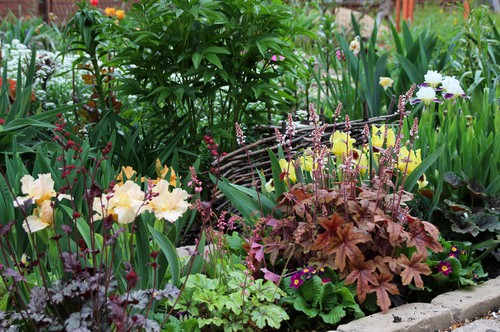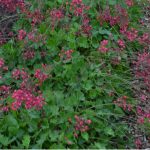Last updated on April 22nd, 2022
Our site is reader supported, this means we may earn a small commission from Amazon and other affiliates when you buy through links on our site.
Heucheras are traditionally foliage plants and there are many varieties available today. These plants have a woody crown with bell-shaped flowers that run the length of their tall stems, hence their nickname “Coral Bells”. They are beautiful in colour, with evergreen leaves that will maintain their verdant colour, even in the snow. What’s more, they attract bees and butterflies so you can help our declining population of much-needed bees.
New varieties offer more options, with leaves that take on shades of lime green, gold, purple and rose. Still, with so many to choose from, how can you make more of what you have? Quite simply, by taking cuttings.
Facts:
- Botanical name: Heuchera
- Common names: Coral Bells
- Plant Type: Evergreen perennial flower
- Mature size: 30-45cm
- Sun exposure: Full sun or partial shade
- Soil type: Loamy
- Soil pH: 6.0 to 7.0
- Flowering time: Spring and summer
- Flower colour: Red, pink, coral and white
No matter the type though, you can propagate a successful plant from cuttings.

When to propagate by taking cuttings
Taking cuttings is very easy, as long as you are prepared for the timing of it. This is something you’ll have to mark in your calendar for the autumn. When autumn rolls around check your plant periodically and as soon as you notice new plants are forming at the base of the crown, that’s when you want to go in and take those cuttings. This can differ between the plant varieties and different growing conditions or environments, which is why there’s no specific day or date, it’s really something you’ll have to play by ear.
That being said, get your sharpest set of pruning shears and make sure they are properly sanitised, something you can do with a mixture of rubbing alcohol, white vinegar, or bleach and water. The sharper they are, the better because then you can make a clean cut without any messy incisions. Messy incisions leave your original plants susceptible to diseases.
When you see the new plants forming, cut them off with your sharpest pruning shears and transplant them into individual pots.
Choosing the right pots or trays
The pots or trays into which you transplant should be things like small pots or even plug trays. You can purchase propagating units that have everything you need and come with specially-designed plastic bottoms and matching tops that have dials on the top, allowing you to further control the humidity inside.
But you don’t have to invest in a propagator if you aren’t planning to propagate on a regular basis. You can always use a homemade construction, made using any type of pot that is small enough to contain the cutting with a makeshift plastic top. The plastic top can be a plastic box, a plastic cup, basically anything that you are able to successfully place over the top to create a greenhouse effect. It is important that once the ‘lid’ is on top, it doesn’t touch the cutting.
Many people get away with adding a plastic bag and affixing it securely with a rubber band and then putting something like chopsticks inside the perimeter of the pot to prevent the plastic bag from touching the plant, forming a tent. The possibilities are endless.
- DESIGN: The Agralan Plug Plant Trainer, for seeds and cuttings allows you to grow plants like the professionals on your own windowsill/ greenhouse. This compact plant trainer from Agralan will allow you to effortlessly grow successful plug plants from seed.
- EASY TO USE: To start, simply fill the 49 cells with compost, plant seeds, cover with self-watering lid and fill the reservoir with water.
- SELF WATERING: Watering is easy, simply pour water into the bottom tray. The clear lid may be turned through 90 degrees to allow ventilation.
- TRANSPLANTING: Designed for minimum impact on roots. When the plants are ready to move on, simply remove the cover and push down the plug section. The plant 'plugs' will pop up automatically for safe and easy transplanting. No squeezing!
- SPECIFICATIONS: The Plant Trainer is robustly manufactured from recycled plastic and may be re-used many times over. SIZE: Height 14cm. Base 22.5 x 20cm.
- Deep Rootrainers are the workhorse of the range - suitable for propagating and cultivating nearly all plants, trees, shrubs, herbaceous, fruit and vegetables; especially those that have deep fast growing roots such as sweet peas and beans.
- Each pack contains: 1 holding tray, 8 books x 4 cells 12cm deep and a clear propagating lid.
- Rootrainers encourage vigorous & strong root formation; roots grow straight, avoiding root balls and pot bound plants.
- Opening the Rootrainer up in a book-like fashion allows for easy inspection of moisture levels and root progress, as well as satisfyingly easy removal of the young plants.
- Tray Size: Length 36cm (15") x Width 22cm (9") x Depth 9cm (3.5").
How to propagate
- Only remove a mature leaf that has one or two stems and has about 5cm worth of stem. We recommend trying to cut into the soil to get a stem that is more mature.
- Add some root powder to the stem and then plant the little plantlet into a small pot.
- These pots should contain a mixture of three parts perlite and one part peat moss.
- Water them thoroughly so they are properly moistened.
- Place the stems upright into the mixture.
- Cover the pots with a plastic bag (or other plastic covering) and secure them. Make sure it is not touching the leaf cutting.
- Place the pots in indirect sunlight. Within a few weeks, you should notice roots starting to come out of the bottom of the pot.
- When the threat of frost is over, and they have a good root system, you can transplant them outside. This is usually around late April.

Heuchera transplantation and providing ideal growing conditions
Make sure wherever you transplant your Heucheras you provide the best growing environment for your plants. They thrive in full sun or partial shade so it’s important to give them an area that has a lot of sunlight and a lot of air. A dry, sunny location will help prevent problems with fungus and disease.
They also enjoy neutral to slightly acidic levels of soil. You can test the soil before you transplant your new cuttings. More importantly, is to make sure that the area where you are going to transplant has good drainage. Drainage is crucial to the survival of your plants. If the crown sits in damp soil it will ruin the plant.
Watering
You will need to provide a medium amount of water to keep the soil moist at all times without drowning the plant. They can go a few weeks without water but it’s always best to give them a good watering when the soil starts to become a little dry on the surface being careful not to overwater.
Feeding
It’s also best to feed your Heucheras with some slow-release fertiliser or compost in the spring. They don’t have a lot of heavy feeding requirements so slow-release fertilisers often work best.
Winter protection
In the winter you can mulch around the base of the plants to prevent them from freezing and to make sure the roots are not exposed.
Once that is done you will have successfully transplanted and propagated from a cutting.

Varieties of Heuchera to try
There are plenty of varieties that can be propagated by taking cuttings. These are some of the fan favourites:
Autumn Leaves
This is known for the foliage changing colour throughout the seasons, especially in autumn. It goes from red to caramel leaves and then to the colour of ruby.
Chocolate Ruffles
As the name suggests, it has a rich chocolate colour on top of the leaves and is accented with burgundy on the bottom of the leaves.
Green Spice
This plant has green leaves that are highlighted by deep maroon veins.
Marmalade
This variety produces foliage in a range of colours, ranging from amber to burnt sienna.
Tiramisu
The leaves on this variety are tinged with red, and its colours will change as the season goes on.
Last update on 2025-01-28 / Affiliate links / Images from Amazon Product Advertising API




